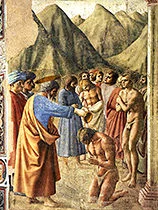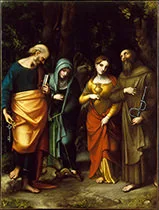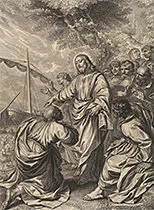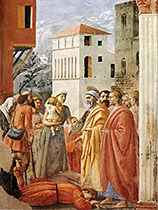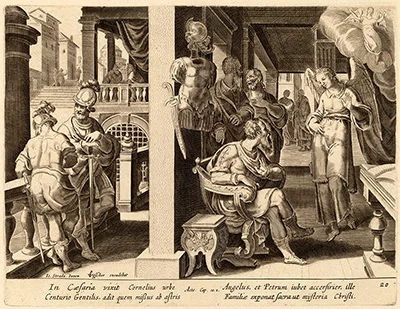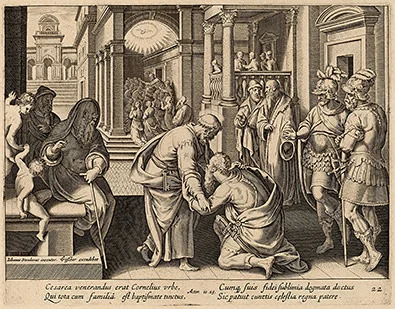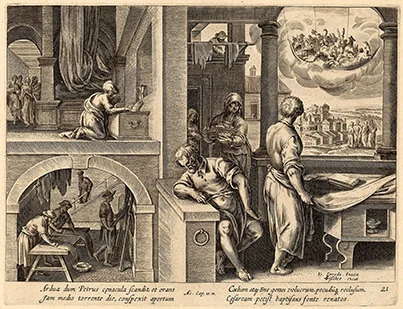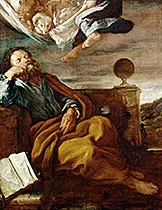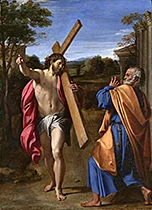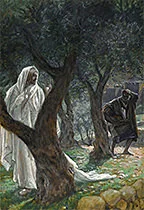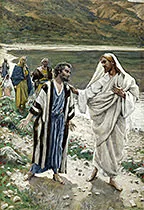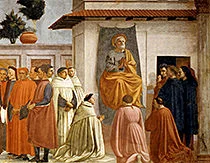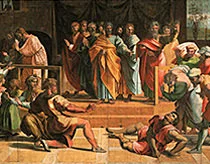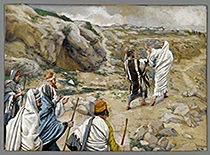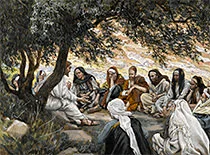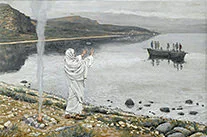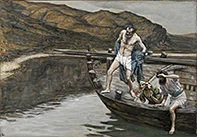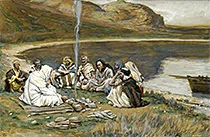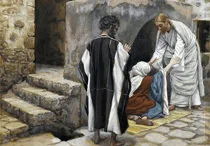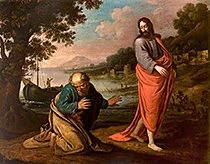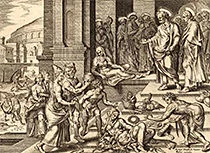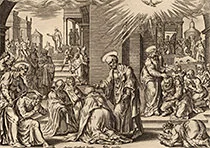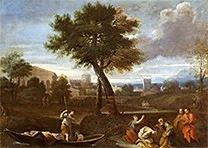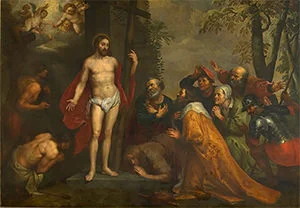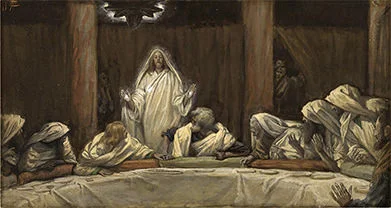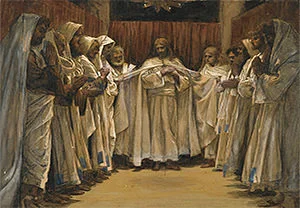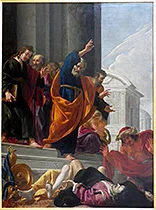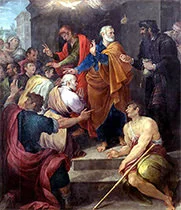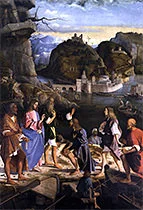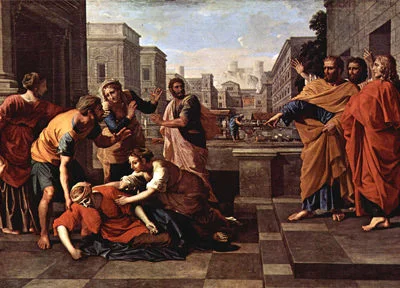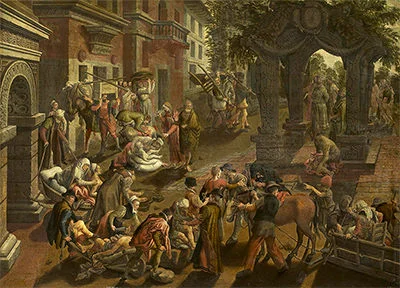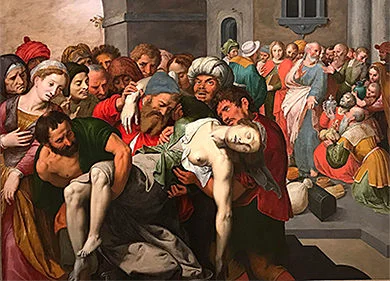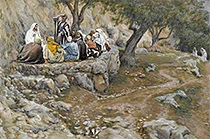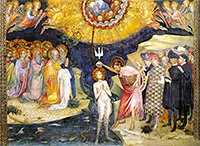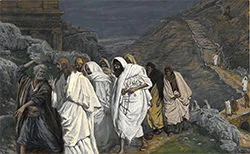The Art World Commemorates Peter
— Album 7 of 17 Photo Albums —
Warren Camp’s presentation of 550 famous “Peter” works of art includes historic paintings, frescoes, stained glass, etchings, sculptures, engravings, and other artwork monuments. They come from the Gothic (1100–1400), High Renaissance, Baroque, Rococo, Neoclassical, and Romantic (1800s) eras.
All are popular works, designed and created by celebrated artists, many of whom you’ll likely recognize, including Rembrandt, Raphael, Michelangelo, El Greco, Da Vinci, Masaccio, Huret, Galle, Tissot, Botticelli, Dürer, Rubens, and many more. They’ll bring back recollections of your “Art History 101” classes, using Janson’s History of Art textbook.
Whether depicting “Cephas,” “Petrus,” “Simon,” “Simeon,” “Simon Bar-Jonah,” “Simon Peter,” “The Rock,” “Peter,” “Apostle Peter,” or “Saint Peter,” the enlarged images of this acclaimed Bible figure come with factual and enlightening details: the artist’s bio; when each work was created; where it can be seen; applicable Bible passages; background and highlights of each work; and photo sources with copyright notices.
To appreciate the impact that Peter had on numerous art-world masters, be sure to click each thumbnail to enlarge it.
• These photo albums complement the Bible-study commentaries Warren has written for “1st and 2nd Peter,” found here.
…
Album 1 (Peter, alone) | Album 2 | Album 3 | Album 4 | Album 5
Album 6 | Album 7 | Album 8 | Album 9 | Album 10 | Album 11
Album 12 | Album 13 | Album 14 | Album 15 | Album 16 | Album 17
Album topics are shown at the [ ⇓ bottom ⇓ ] of each page.
Miscellaneous New Testament Depictions of Peter
Death of Ananias”
Slide 4
Click to enlarge.
Masaccio — c. 1425
fresco painting
to Fetch Saint Peter”
Slide 5
Click to enlarge.
Galle, 1550–1570, engraved print
to Saint Peter”
Slide 10
Click to enlarge.
Tissot — 1886–1894
watercolor on paper
‘Feed My Lambs’”
Slide 11
Click to enlarge.
Tissot — 1886–1894
watercolor on paper
(Cartoon for Tapestry)
Slide 13
Click to enlarge.
Raphael — 1515–1516
tempera on paper
Shore of Tiberius”
Slide 16
Click to enlarge.
Tissot — 1886–1894
watercolor on paper
into the Water”
Slide 17
Click to enlarge.
Tissot — 1886–1894
watercolor on paper
and the Apostles”
Slide 18
Click to enlarge.
Tissot — 1886–1894
watercolor on paper
Mother-in-Law”
Slide 19
Click to enlarge.
Tissot — 1886–1894
watercolor on paper
or Calling Saint Peter”
Slide 20
Click to enlarge.
Flemish School — 1600
oil on canvas
Receive God’s Word”
Slide 22
Click to enlarge.
Galle — 1575–1582
engraved print
Baptizing Cornelius”
Slide 23
Click to enlarge.
Grimaldi — 1626–1680
oil on copper
at the Cenacle” (Upper Room)
Slide 25
Click to enlarge.
James Tissot, 1886–1894
watercolor over graphite on paper
Slide 34
Click to enlarge.
Lorenzo Salimbeni, c. 1416
painted fresco
- 1. “The Baptism of the Neophytes,” fresco painting by Masaccio, 1426–1427
Baptism of the Neophytes It’s important to know what a “neophyte” is before we search for them in the New Testament. A “neophyte” is a person who’s new to a subject, skill, or belief: a proselyte or new convert to a religion. In the early Church it was the name given to Christian converts who’d been baptism. Apostle Paul wrote this about neophytes: “Or don’t you know that all of us who were baptized into Christ Jesus were baptized into his death? We were therefore buried with him through baptism into death in order that, just as Christ was raised from the dead through the glory of the Father, we too may live a new life” (Romans 6:3–4).
The career of Masaccio was lamentably short, lasting only about six years. In this fresco he intentionally shows “a religious figure sharing the focal point of the painting, alongside the sinner whom he baptizes. Peter (left), baptizing the neophyte, pours from a bowl holy water onto the man’s head. The kneeling neophyte wears a white cloth along his waist.”[1] “Giorgio Vasari, a foremost artist of 16th-century Italy wrote: ‘… a standing nude trembling because of the cold, amongst the other neophytes, executed with such fine relief and gentle manner, that it is highly praised and admired by all artists, ancient and modern; it displays such skill and a sure hand, as well as a novel pictorial technique, that it almost seems to herald the art of Michelangelo in the Sistine Chapel.’
“The cold, flowing water of the river presses against the legs of the kneeling neophyte; the water that Peter pours from the bowl, with a gesture rather like that of a farmer sowing his seeds, splashes onto the man’s head, drenching his hair and dribbling off in rivulets.”[2]
… Height: 8.4 ft. (255 cm), width: 5.3 ft. (162 cm)
… Photo source, license, attribution, and enlargement: public domain, via Web Gallery of Art; Cappella Brancacci, Santa Maria del Carmine, Florence
… The artist’s short biography; his other works of art
Return to “Peter Masterpieces” album’s opening page or to the top of this page or open the next album.
- 2. “Saints Peter, Martha, Mary Magdalene,” oil on canvas, painted by Correggio, c. 1515
Saints Peter, Martha, Mary Magdalene, and Leonard by Correggio “One of Correggio’s most significant early works, this altarpiece was painted for a church in the artist’s hometown (Correggio). Four saints, each lost in his or her own thoughts, are shown before a dark forest grove, illuminated by a soft light. The four saints were chosen by the patron [sponsor], Melchiore Fassi. Correggio was one of the most original painters of the Renaissance, and in this early picture he explored ideas put into circulation by Leonardo da Vinci, seeking a haunting ambiguity of expression and a soft, enveloping light.
“According to the Golden Legend [not the Bible!], Martha [second from left], her sister Mary Magdalene, and their followers made their way to France. Martha dwelled in a deep forest, where she saved the populace from a dragon that she tamed by a sprinkle of holy water from her aspergillum [an implement for sprinkling holy water] and then attached to her girdle as we see in the painting. It is her story that provides the rationale for the deep forest with twisted tree trunks forming a backdrop to the gathering of saints, a remarkable scene probably inspired by Leonardo da Vinci’s work in Milan, which was also the inspiration for the Magdalene’s idealized beauty.”[1]
“The artist carefully studied how to vary poses, gestures, and looks, with two of the figures looking downwards (Peter and Martha), one looking up (Leonard), and one looking toward the viewer (Mary). Her slight smile also draws on the style of Leonardo da Vinci, most notably in the Mona Lisa.”[2]
… Height: 87 1/4 in. (221.6 cm), width: 63 3/4 in. (161.9 cm)
… Photo source, license, attribution, museum details, and image enlargement: The Met; John Stewart Kennedy Fund, 1912
… The artist’s short biography; his other works of art
Return to “Peter Masterpieces” album’s opening page or to the top of this page or open the next album. - 3. “Christ Giving Custody of His Herds to St Peter,” print engraved by Grégoire Huret, 1664
“Christ Giving Custody of His Herds to St Peter” (Plate 30, from The Passion of Christ): Grégoire Huret was a French Old Masters artist who was born in 1606 and died in 1670. An accomplished engraver, draftsman, and architect in France, he was trained in Lyon before moving to Paris by 1635. Very little has been written about his life and artistic achievements.
This engraving of Huret is one of his thirty-two engravings in a series he titled “The Passion of Christ.” You can see them all here, compliments of The Met. While his series includes depictions of Jesus before and after his crucifixion, Huret’s “Christ Giving Custody of His Herds to St Peter” engraving highlights a post-resurrection scene taken from John’s gospel account (shown below).
Looking closely above at the artist’s footer, atop its center are the Roman numerals “X X X,” which identify this plate number as “30.” Beneath it we see the Roman text of John 21:15–17. This passage about Peter being given custody of Christ’s herd of lambs follows John’s gospel account of Jesus’ appearing, after his resurrection, to Mary Magdalene (21:11–18), then his disciples (vv. 19–23), and Thomas (vv. 24–29), then following the miraculous catch of 153 fish (21:1–11), and subsequently the breakfast that Jesus shared with seven of his disciples at the Sea of Galilee (vv. 12–14).
Read the English translation of John 21:15–17 titled “Jesus Reinstates Peter.” And see several “Miraculous Catch of Fish” paintings in our Album 5.
… Height: 19 15/16 in. (50.7 cm), width: 14 in. (35.5 cm)
… Photo source, license, attribution, museum details, and image enlargement: The Met; Harris Brisbane Dick Fund, 1953
… No Huret biography found; view his other works of art
Return to “Peter Masterpieces” album’s opening page or to the top of this page or open the next album.
- 4. “Distribution of Alms and Death of Ananias,” fresco painted by Masaccio, c. 1424–1425
Masaccio (1401–1428) painted his “Distribution of Alms and Death of Ananias” fresco, bringing together two episodes in Luke’s second volume: Acts 4:32–5:11. The scene has a combined focus: (1) a woman, carrying a child and standing in front of haloed Peter, who stands next to John, receives alms from him; (2) the immediate collapse of a man named Ananias who’s just fallen on the ground with one leg up, about to die in front of everyone.
Detailing the first account, Masaccio shows Peter actively distributing alms or donations that people had agreed to share with needy believers, thereby miraculously creating the eventual situation in which “God’s grace was so powerfully at work in them all that there were no needy persons among them” (vv. 33–34). In the second account, Luke describes the immediate death of Ananias who sold a piece of land and lied to the Holy Spirit, pretending to lay the sale’s entire proceeds at the apostle’s feet. “This scene takes place in a setting of great solemnity, and the classical composition is constructed around opposing groups of characters; it describes both a new measure guaranteeing greater equality among the population and the divine punishment of those who make false declarations.”[1]
Herein, “Masaccio’s figures move inside a natural setting. The composition is tight and emotional, involving the viewer in the heart of the event, with a background that includes buildings drawn in perspective. In this fresco painting, Masaccio brings together the two moments of the story: Peter distributing donations that have been presented to the apostles, and the death of Ananias, whose body lies on the ground at Peter’s feet.”[2]
… Height: 7.5 ft. (230 cm), width: 5.3 ft. (162 cm)
… Photo source, license, attribution, museum details, and image enlargement: Masaccio, public domain, via Wikimedia Commons
… The artist’s short biography; his other works of art
Return to “Peter Masterpieces” album’s opening page or to the top of this page or open the next album. - 5. “Angel Commands Cornelius to Fetch Saint Peter,” engraving by Philip Galle, 1550–1570
Philip (or Philips) Galle, born in Haarlem, Netherlands (1537), was a Dutch draftsman, engraver, publisher, print dealer, writer, and historian. He’s especially known for his reproductive engravings of paintings. He also developed a style in his etchings that featured cross- and parallel-hatching that effectively produced shades of gray toward black. Galle’s practice gave his engravings a dark, silklike look.
“Angel Commands Cornelius to Fetch Saint Peter” (engraved by Galle after Jan van der Straet): “Acts 10:1–8 introduces the first group of non-Jewish Gentiles to receive the Holy Spirit. Cornelius is a Roman military leader stationed in Caesarea Maritima, the coastal city that serves as the headquarters for Herod Agrippa I. Cornelius is a devout follower of the Jewish God, although probably not a full proselyte. While praying one day, an angel [above, right] appears and tells him that God has heard his prayers and appreciates his charity. He is to send for Peter in Joppa and hear what the apostle has to say. What follows is the opening of the gospel to all Gentiles.”[1]
The Bible reference that motivated Galle to create this detailed engraving of plate 20 of 34 (including the title plate) is shown in the center of its footer: “Acto. Cap. 10.1” for Acts 10:1. You can read this passage titled “Cornelius Calls for Peter” in Acts 10:1–8.
… Height: 7.9 in. (200 mm), width: 10.4 in. (265 mm)
… Photo source, license, attribution, museum details, and image enlargement: National Gallery of Art; Ailsa Mellon Bruce Fund
… The artist’s short biography; his other works of art
… There are sixteen Galle engravings of Apostle Peter in “Peter Masterpieces”: Album 3 (3@); 5 (4@); 6 (2@); 7 (5@); 10; and 14.
Return to “Peter Masterpieces” album’s opening page or to the top of this page or open the next album. - 6. “Cornelius Worshiping Saint Peter,” engraving by Philip Galle, 1550–1570
Philip (or Philips) Galle was a Dutch draftsman, engraver, publisher, print dealer, writer, and historian. Born in Haarlem, Netherlands (1537), he developed a style in his etchings that featured cross- and parallel-hatching that effectively produced shades of gray toward black, giving his engravings a dark, silklike look. He’s especially known for his reproductive engravings of paintings.
“Cornelius Worshiping Saint Peter” (engraved by Galle after Jan van der Straet): “Acts 10:24–33 describes the onset of the last step of Jesus’ command for the disciples: to share His story in Jerusalem, Judea, and Samaria, and to the ends of the earth (Acts 1:8). Upon an angel’s prompting [see previous Galle slide], a Roman centurion named Cornelius has sent for Peter. Meanwhile, the Holy Spirit has been teaching Peter that non-Jews are no longer unclean (10:1–23). Peter will go to Cornelius and bear witness of Jesus. Everyone in earshot will believe Peter and receive the Holy Spirit (vv. 34–48).”[1]
The Bible reference that motivated Galle to create this detailed engraving of plate 22 of 34 (including the title plate) is shown in the center of its footer: “Actor. 10. 25.” for Acts 10:25. Here’s that short verse: “As Peter entered the house, Cornelius met him and fell at his feet in reverence.” You can read this passage titled “Peter at Cornelius’s House” in Acts 10:23–48.
… Height: 7.9 in. (200 mm), width: 10.6 in. (268 mm)
… Photo source, license, attribution, museum details, and image enlargement: National Gallery of Art; Ailsa Mellon Bruce Fund
… The artist’s short biography; his other works of art
… There are sixteen Galle engravings of Apostle Peter in “Peter Masterpieces”: Album 3 (3@); 5 (4@); 6 (2@); 7 (5@); 10; and 14.
Return to “Peter Masterpieces” album’s opening page or to the top of this page or open the next album. - 7. “The Vision of Saint Peter,” engraving by Philip Galle, 1582
Philip (or Philips) Galle, born in Haarlem, Netherlands (1537), was a Dutch draftsman, engraver, publisher, print dealer, writer, and historian. He’s especially known for his reproductive engravings of paintings.
“The Vision of Saint Peter” (engraved by Galle after Jan van der Straet): “Acts 10:9–23 occurs as Peter is in Joppa, after having healed a paralyzed man in nearby Lydda and having raised Tabitha from the dead in Joppa (9:32–43). Peter doesn’t know that a Roman centurion who worships the Jewish God is sending three men to bring Peter to Caesarea. The centurion wished to learn what God has planned for him, which he will find is for him to be saved in Jesus’ name. First, God makes Peter understand that Jesus’ offer of salvation is as available for non-Jewish Gentiles as it is for Jews.”[1]
The Bible reference that motivated Galle to create this detailed engraving of plate 21 of 34 is shown in the center of its footer: “Ac. Cap. 10. 11.” for Acts 10:11. Here’s that short verse: “[Peter] saw heaven opened and something like a large sheet being let down to earth by its four corners.” In the sheet are ‘all kinds of four-footed animals, as well as reptiles and birds’ (v. 12). A voice tells Peter to kill and eat the animals (v. 13) but some of these creatures are not allowed by Mosaic law to be eaten. They represent people of the world who have been elected by God — some are devout Jews, some aren’t, but Jesus wants Peter to accept them all. You can read this passage titled “Peter at Cornelius’s House” in Acts 10:9–23.
… Height: 8 in. (203 mm), width: 10.6 in. (270 mm)
… Photo source, license, attribution, museum details, and image enlargement: National Gallery of Art; Ailsa Mellon Bruce Fund
… The artist’s short biography; his other works of art
… There are sixteen Galle engravings of Apostle Peter in “Peter Masterpieces”: Album 3 (3@); 5 (4@); 6 (2@); 7 (5@); 10; and 14.
Return to “Peter Masterpieces” album’s opening page or to the top of this page or open the next album.
- 8. “Peter’s Vision of Unclean Animals,” oil on poplar wood, painted by Domenico Fetti, c. 1619
Peter’s Vision of Unclean Animals In Luke-Acts, chapter 10, “Saint Peter had a vision of a great sheet descending upon him, a sheet knit at four corners, full of animals being lowered from heaven (v. 11). A voice from heaven was heard — ‘Get up, Peter. Kill and eat.’ — but since the sheet contained unclean animals, Peter declined. The command was repeated two more times, along with the voice saying, ‘Do not call anything impure that God has made clean’ (v. 15) and then ‘immediately the sheet was taken back to heaven.’ (v. 16). At this point in the narrative, messengers sent from Cornelius the Centurion arrive and urge Peter to go with them. He does so, and mentions the vision as he speaks to Cornelius, saying, ‘God has shown me that I should not call anyone impure or unclean’ (v. 28).
“Peter’s vision was rarely shown in art, but has been illustrated in this pen-and-ink drawing by Rembrandt, c. 1658. Rembrandt was probably reacting to this Domenico Fetti painting, which was then in Amsterdam but is now in Vienna.”[1]
“Three, . . . three, . . . three” “Whether or not the number three has specific importance in God’s point of view, it’s significant for Peter. While Jesus was on trial before the Sanhedrin, Peter denied knowing Him three times (Mark 14:66–72). After Jesus had risen from the dead, Jesus asked Peter three times if he loved Him, and told Peter to take care of Jesus’ followers (John 21:15–17). It’s possible Peter sees the animals or hears the voice three times because that will make him recognize it as a message from Jesus. It certainly seems to link the newly-clean animals with Peter’s responsibility to proclaim Jesus’ message and care for His followers with what is about to happen: three messengers coming to bring Peter to a Roman centurion to share the gospel.”[1]
… Height: 25.9 in. (66 cm), width: 20 in. (51 cm)
… Photo source, license, attribution, museum details, and image enlargement: Domenico Fetti, public domain, via Wikimedia Commons
… The artist’s short biography; his other works of art
Return to “Peter Masterpieces” album’s opening page or to the top of this page or open the next album.
- 9. “Christ appearing to Saint Peter on the Appian Way,” oil on panel, painted by Annibale Carracci, 1601–1602
“Domine, Quo Vadis?” (Lord, Where Are You Going?) “Saint Peter fled Rome after Christ’s crucifixion, scared that he too would be executed by the Romans; here, he stands in shock as Christ passes him on the road. When Peter asked Christ where he was going — see the question in this painting’s Latin title — he replied that he was headed to Rome to be crucified again. Shamed, Peter turned back to face his own martyrdom. The incident [not mentioned in the New Testament] is described in the Golden Legend, a thirteenth-century compilation of the lives of the saints.”[1]
“The “story” states that Peter was freed from prison in Rome after he and Paul converted their jailers. Peter was then persuaded by fellow Christians who were concerned for his safety, to flee Rome. As he left, Peter encountered the resurrected Jesus. Astonished, Peter asked: ‘Domine quo vadis?’ (‘Lord, where are you going?’). Jesus replied, ‘I go to Rome to be crucified anew.’ When he heard these words, Peter understood that his own actions were cowardly and that he must return to Rome. There, he was arrested and [supposedly] crucified upside down, at his request, because he did not feel worthy of dying as Jesus had.
“Herein, Jesus appears in his resurrected body; it is muscular but bears the wounds of the crucifixion. He wears a white loin cloth and a red mantle over his shoulder (red symbolizes his humanity and the blood shed at his passion). Peter is identified by his traditional blue and yellow robes, gray hair and beard, and the keys hanging at his waist. Taken aback by the muscular figure of Jesus, Peter’s hands are up in a protective mode as he recoils in astonishment.”[2]
… Height: 30.5 in. (77.4 cm), width: 22.2 in. (56.3 cm)
… Photo source, license, attribution, museum details, and image enlargement: The National Gallery, London, UK
… The artist’s short biography; his other works of art
Return to “Peter Masterpieces” album’s opening page or to the top of this page or open the next album. - 10. “Apparition of Our Lord to Saint Peter,” watercolor on paper, painted by James Tissot, 1886–1894
[ James Tissot (French, 1836–1902): “Apparition of Our Lord to Saint Peter (Apparition de Notre-Seigneur à St-Pierre),” 1886–1894. Brooklyn Museum, purchased by public subscription, 00.159.336 (Photo: Brooklyn Museum, 00.159.336_PS1.jpg); see Tissot’s “Life of Christ” collection of 124 watercolors that depict detailed New Testament scenes.]
Apparition of Our Lord to Saint Peter Luke records for us in his first volume — his gospel account — the story of Jesus walking on the road to the village of Emmaus. On the way, he came upon two disciples but they couldn’t recognize him. Asking them what they were talking about, they answered, “About Jesus of Nazareth, . . . the chief priests and our rulers handed him over to be sentenced to death, and they crucified him.” When they came to the village, Jesus went inside with them for dinner. He sat at the table with them, took bread, gave thanks, broke it, and began to give it to them. Their eyes were then opened and they recognized him, but he disappeared from their sight. At once, the two disciples got up and returned to Jerusalem where they found the Eleven and those assembled with them. They told everyone, “It is true! The Lord has risen and has appeared to Simon” (Luke 24:13–35).
In James Tissot’s watercolor portrayal of Luke’s account of the apparition of Lord Jesus to Peter (v. 34), Jesus Christ appears to Peter. To ease Peter’s fear and remove any doubt, the Lord reassured Peter of his identity by lifting up both nail-wounded hands toward Peter so he could see the punctures that had been left on Jesus’ body as a result of the crucifixion. Tissot handily highlights in bright white the stigmata marks on Jesus’ hands and his one visible foot. Note: “Tissot placed Jesus’s wounds on his ‘hands’ (Greek cheir), not on his wrist, but their exact location is a minor issue.[1]
… Height: 11 1/2 in. (29.2 cm), width: 7 15/16 in. (20.2 cm)
… Photo source, license, attribution, and museum details: Brooklyn Museum of Art; purchased by public subscription
… The artist’s short biography; his other works of art
Return to “Peter Masterpieces” album’s opening page or to the top of this page or open the next album. - 11. “Feed My Lambs,” watercolor on paper, painted by James Tissot, 1886–1894
[ James Tissot (French, 1836–1902): “Feed My Lambs (Pais mes brebis),” 1886–1894. Brooklyn Museum, purchased by public subscription, 00.159.347 (Photo: Brooklyn Museum, 00.159.347_PS1.jpg); see Tissot’s “Life of Christ” collection of 124 watercolors selected from a set of 350 that depict detailed New Testament scenes.]
Jesus said, “Feed my lambs” The New Testament passage from which James Tissot composed this rendering is from the gospel account of Apostle John, 12:1–19. It’s the passage titled “Jesus and the Miraculous Catch of Fish” (NIV). [Note: Warren Camp presents seven artistic masterpieces on this subject in his Album 5.] This story takes place on the Sea of Galilee (or Tiberius) where seven disciples of Christ, after his resurrection but unrecognized by them, had fished but caught nothing. After he told them, “Throw your net on the right side of the boat and you will find some” (v. 6), they were unable to haul the net in because of the large number of fish they’d caught: 153! After hearing from John that he’d recognized the man on the shore as Jesus, Peter jumped into the water to reach Jesus who was cooking fish and bread by a fire. Jesus invited them all to “Come and have breakfast” (v. 12). [See Tissot’s Breakfast painting here.]
It’s the next portion of this gospel passage that this watercolor focuses upon. John 21:15–19 “is a poignant moment between Peter and the resurrected Jesus. Not many days before this breakfast on the beach, Peter stood near a fire, three times denying that he knew Christ (18:25–27). Now, in front of another fire, Jesus asks Peter to affirm his faithful love three times: ‘Yes, Lord,’ he said, ‘you know that I love you.’ Jesus said, ‘Feed my lambs.’ Peter grasps the symbolism. Jesus affirms Peter’s calling to serve Him and predicts the matter of Peter’s death.”[1]
… Height: 9 5/8 in. (24.4 cm), width: 6 3/8 in. (16.2 cm)
… Photo source, license, attribution, and museum details: Brooklyn Museum of Art; purchased by public subscription
… The artist’s short biography; his other works of art
Return to “Peter Masterpieces” album’s opening page or to the top of this page or open the next album. - 12. “Enthroned Peter Sits and Preaches,” half a fresco painting by Masaccio, 1426–1427
Enthroned Peter Sits and Preaches The photo above highlights the right half of a composite narrative painted by Masaccio. The picture of Saint Peter sitting in his elevated chair is set as “a picture within the picture.” As might be expected in a Renaissance painting, several of the figures are believed to be important Florentines of the day. The group of four at the far right is of particular interest: It’s claimed that they represent [r. to l.] Filippo Brunelleschi, Leon Alberti, Masaccio (his self-portrait detailed here), and short Masolino da Panicale.
It’s important to realize that there’s no biblical account of Peter sitting elevated on a chair or being enthroned. The above-depicted story (with its left-side composite narrative titled “Raising of the Son of Theophilus,” shown here) was derived from the fictional Golden Legend, a 13th-century book that compiles traditional lore about saints venerated at the time of its compilation. Today it’s considered the closest thing to an encyclopedia of medieval saint lore.
Sadly, Masaccio’s career was short, lasting only about six years. He radically transformed Florentine painting. And his art eventually helped create many of the major conceptual and stylistic foundations of Western painting. Seldom do we see such a brief life being vitally important to art history. You can see this and his other frescoes in the Brancacci Chapel.
… Dimensions of entire composite narrative: height: 7.5 ft. (230 cm), width: 19.6 ft. (598 cm)
… Photo source, license, attribution, museum details, and image enlargement: Masaccio, public domain, via Wikimedia Commons
… The artist’s short biography; his other works of art
Return to “Peter Masterpieces” album’s opening page or to the top of this page or open the next album. - 13. “The Death of Ananias (Cartoon for Tapestry),” tempera on paper, painted by Raphael, 1515–1516
The Death of Ananias “The Raphael Cartoons are designs for tapestries and were commissioned from Raphael by Pope Leo X (reg. 1513–21). The tapestries were intended to hang in the Sistine Chapel in Rome, built by one of Leo’s predecessors: Pope Sixtus IV (reg. 1471–84). The Chapel was primarily intended for the use of the pope and the body of clergy and laity immediately surrounding him. The tapestries continued this theme, illustrating scenes from the lives of Saint Peter and Saint Paul, who were seen as the founders of the Christian Church. The resulting tapestries had, in addition, woven borders showing scenes from Pope Leo’s life and from the lives of Saint Paul, also designed by Raphael: These cartoons did not survive.
In this cartoon, taken from Luke’s second volume, Acts 5:1–10, “Peter’s miracles can both heal or punish sins. Here he punishes a man for disobedience. The apostles have asked Christian followers to sell their property and donate the proceeds to the community. A man called Ananias secretly kept some of the money for himself. Interrogated by Peter, Ananias denied this and fell down dead. He committed two sins: lying and stealing from the Church.”[1] “Raphael’s cartoons are the earliest surviving examples of tapestry cartoons on paper. It took him and his workshop a little more than a year to complete the Sistine Chapel’ ten tapestry cartoons. Their cost was 16,000 ducats (± 2.4 million dollars today), more than five times the amount paid to Michelangelo for painting the Sistine Chapel ceiling.”[2] Learn “The Story of Raphael’s Cartoons,” which are considered one of the greatest treasures of the Renaissance period.
… Height: 12.6 ft. (385 cm), width: 14.4 ft. (440 cm)
… Photo source, license, attribution, museum details, and image enlargement: Raphael, public domain, via Wikimedia Commons
… The artist’s short biography; his other works of art; his seven tapestry cartoons
Return to “Peter Masterpieces” album’s opening page or to the top of this page or open the next album. - 14. “Get Thee Behind Me, Satan,” watercolor on paper, painted by James Tissot, 1886–1896
[ James Tissot (French, 1836–1902): “Get Thee Behind Me, Satan (Rétire-toi, Satan),” 1886–1896. Brooklyn Museum, purchased by public subscription, 00.159.153 (Photo: Brooklyn Museum, 00.159.153_PS1.jpg); see Tissot’s “Life of Christ” collection of 124 watercolors selected from a set of 350 that depict detailed New Testament scenes.]
James Tissot “Born in France, he enjoyed great success as a society painter in Paris and London (1870s and 1880s). Visiting a church, he had a religious vision, after which he abandoned his former subjects and embarked on an ambitious project to illustrate the New Testament. To prepare, he made expeditions to the Middle East to record the landscape, architecture, costumes, and customs of the Holy Land and its people. He painted his many figures in costumes he believed to be historically authentic, carrying out his series with considerable archaeological exactitude.”[1] No one who’d followed Tissot’s previous career could have anticipated that he’d pursue painting virtually every event that occurred in the four gospels. “The Life of Our Lord Jesus Christ” project took nearly ten years to complete. It chronicled the entire life of Jesus as recorded in the New Testament. This painting is one of them.
“Get Thee Behind Me, Satan!” Gospel writers Mark and Matthew record this account for us. Here’s Mark’s text highlighting Peter calling Jesus aside and chastising him: “He then began to teach them that the Son of Man must suffer many things and be rejected by the elders, the chief priests, and the teachers of the law, and that he must be killed and after three days rise again. He spoke plainly about this, and Peter took him aside and began to rebuke him. But when Jesus turned and looked at his disciples, he rebuked Peter. ‘Get behind me, Satan!’ he said. ‘You do not have in mind the concerns of God, but merely human concerns’” (Mark 8:31–33). Find a similar account in Matt. 16:21–28.
… Height: 5 11/16 in. (14.4 cm), width: 8 5/8 in. (21.9 cm)
… Photo source, license, attribution, and museum details: Brooklyn Museum of Art; purchased by public subscription
… The artist’s short biography; his other works of art
Return to “Peter Masterpieces” album’s opening page or to the top of this page or open the next album. - 15. “The Exhortation to the Apostles,” watercolor on paper, painted by James Tissot, 1886–1896
[ James Tissot (French, 1836–1902): “The Exhortation to the Apostles (Recommendation aux apôtres),” 1886–1896. Brooklyn Museum, purchased by public subscription, 00.159.129 (Photo: Brooklyn Museum, 00.159.129_PS1.jpg); see Tissot’s “Life of Christ” collection of 124 watercolors selected from a set of 350 that depict detailed New Testament scenes.]
The Life of Our Lord Jesus Christ No one who’d followed Tissot’s previous career could have anticipated that this painter of urban life in Paris and London would undertake a project of painting virtually every event that occurred in the four gospels. “The Life of Our Lord Jesus Christ” project took nearly ten years to complete. When it was done, a series of 350 watercolors chronicled the entire life of Jesus as recorded in the New Testament.
“The Exhortation to the Apostles” The painting is a beautifully detailed portrait of Jesus speaking to his twelve chosen apostles as each listens attentively to him. Tissot was known for two things: In the early part of his life he painted highly detailed portraits of Victorian society; in the latter part he painted popular Bible portraits. The biblical paintings, such as this one, were done in a more relaxed, impressionistic, and decorative style. Tissot was particularly adept at painting larger groups such as this one. Herein, Tissot depicts Jesus, who’d called his Twelve together, to delegate his work to them. He also gave them power to do what he’d called them to do: to have power over all demons, preach and proclaim to all about the kingdom of God, and to heal the sick. Jesus’ specific exhortation to his apostles can be found in Luke’s gospel (9:1–5). They departed and did what Jesus told them to do.
… Height: 6 1/2 in. (16.5 cm), width: 8 3/4 in. (22.2 cm)
… Photo source, license, attribution, and museum details: Brooklyn Museum of Art; purchased by public subscription
… The artist’s short biography; his other works of art
Return to “Peter Masterpieces” album’s opening page or to the top of this page or open the next album. - 16. “Christ Appears on the Shore of Tiberius,” watercolor on paper, painted by James Tissot, 1886–1894
[ James Tissot (French, 1836–1902): “Christ Appears on the Shore of Lake Tiberias (Apparition du Christ sur les bords du lac de Tibériade),” 1886–1894. Brooklyn Museum, purchased by public subscription, 00.159.343 (Photo: Brooklyn Museum, 00.159.343_PS1.jpg); see Tissot’s “Life of Christ” collection.]
Christ Appears on the Shore of Lake Tiberias This painting is another from the Brooklyn Meseum’s exhibition James Tissot: “The Life of Christ,” which includes 124 watercolors selected from a set of 350 that depict detailed New Testament scenes, from before the birth of Jesus through the Resurrection, in a chronological narrative. This and the next two slides illustrate the passage in which post-resurrection Jesus greets seven of his disciples and prepares breakfast for them: John 21:1–14.
This painting is a beautiful beckoning presentation of Jesus, seen from behind, standing on the seashore, calling to his disciples who are in two boats on the lake. Behind him is a small fire bordered by stones (vv. 4–6). “Peter and six other disciples have returned to Galilee after Jesus’ resurrection. Most of these were fishermen before Christ called them. In one of His earlier lessons, Jesus directed Peter to make what seemed to be a pointless change in his technique: to cast the net on the other side of the boat. The result was a catch of fish so large it nearly sank two boats. Peter recognized that this wasn’t just a lucky guess, but a supernatural miracle. As the sun rises, they see a figure on shore who calls out. Peter will once again understand that it is the Son of God who is speaking.”[1]
Next in Tissot’s series are the two follow-up scenes: Peter’s jump into the water and the intimate breakfast shared ashore, compliments of the Lord, Jesus.
… Height: 5 7/8 in. (14.9 cm), width: 9 1/16 in. (23 cm)
… Photo source, license, attribution, and museum details: Brooklyn Museum of Art; purchased by public subscription
… The artist’s short biography; his other works of art
Return to “Peter Masterpieces” album’s opening page or to the top of this page or open the next album.
- 17. “Saint Peter Casts Himself into the Water,” watercolor on paper, painted by James Tissot, 1886–1894
[ James Tissot (French, 1836–1902): “Saint Peter Alerted by Saint John to the Presence of the Lord Casts Himself into the Water (Saint Pierre averti par Saint Jean que le Seigneur est là se jette à l'eau),” 1886–1894. Brooklyn Museum, purchased by public subscription, 00.159.344 (Photo: Brooklyn Museum, 00.159.344_PS1.jpg)]
Alerted by Saint John to the presence of the Lord, “Saint Peter Casts Himself into the Water” This painting is another from the Brooklyn Meseum’s exhibition James Tissot: “The Life of Christ,” which includes 124 watercolors selected from a set of 350 that depict detailed New Testament scenes, from before the birth of Jesus through the Resurrection, in a chronological narrative. This, and slides 16 and 18, illustrate the passage in which post-resurrection Jesus invites his disciples to enjoy breakfast with him: John 21:1–14.
Tissot’s action shot of Peter shedding his outer garments and preparing to jump into the lake is the opening scene of Jesus’ last breakfast. The previous night, the guys hadn’t caught anything. So this dawn, Jesus stood in front of his fire on the lake’s shore, shouting to his disciples this question: “Friends, haven’t you any fish?” “No,” they answered. He said, “Throw your net on the right side of the boat and you will find some.” When they did, they were unable to haul the net in because of the large number of fish (vv. 5–6). The apostle, John, might have wondered, “Hadn’t we previously experienced this miracle?” Then he realized who the man was and declared for all to hear, “It’s the Lord!” Not to be outdone by John, Peter, typically dramatic, dove into the lake and was the first to reach shore. When they all landed, they saw a fire of burning coals there with fish and some bread on it. Jesus said to them, “Bring some of the fish you’ve just caught” (v. 10). The seven happily ate breakfast with their Lord, as you’ll see in Warren’s next slide.
… Height: 6 5/16 in. (16 cm), width: 9 in. (22.9 cm)
… Photo source, license, attribution, and museum details: Brooklyn Museum of Art; purchased by public subscription
… The artist’s short biography; his other works of art
Return to “Peter Masterpieces” album’s opening page or to the top of this page or open the next album. - 18. “Meal of Our Lord and the Apostles,” watercolor on paper, painted by James Tissot, 1886–1894
[ James Tissot (French, 1836–1902): “Meal of Our Lord and the Apostles (Repas de Notre-Seigneur et des apôtres),” 1886–1894. Brooklyn Museum, purchased by public subscription, 00.159.346 (Photo: Brooklyn Museum, 00.159.346_PS1.jpg); see Tissot’s “Life of Christ” collection of 124 watercolors selected from 350 that depict detailed scenes.]
Meal of Our Lord and the Apostles This painting is the third of three that illustrates what occurred before, during, and after the post-resurrection “Second Miraculous Catch of Fish” passage found in John 21:1–14.
Tissot’s series of three “Second Miraculous Catch of Fish” watercolor paintings includes: (1) Jesus, standing on the shore, asking seven disciples if they’d caught fish [see slide 16]; (2) Peter’s dramatic jump into the water and be the firs to reach shore (previous slide); and (3) this barbecue breakfast on the beach, compliments of their Lord. Set in the same cove as the first painting [see slides 16 and 17], Tissot has the disciples sitting in a semi-circle in front of Jesus; their backs are to the sea and their beached boats. Jesus tends the fire and roasts the fish and bread. Note: In keeping with the mystery of Jesus’ resurrection, Tissot doesn’t reveal Lord Jesus’ face in these two paintings.
“The simple act of sharing a meal, especially in the ancient world, represents friendship and trust. After this breakfast, Jesus will address an important issue: Peter’s embarrassing denial of Christ (John 13:36– 18:25–27). In the upcoming conversation, Jesus will poignantly remind Peter of his sin, while restoring him to his calling (John 21:17–19).”[1]
… Height: 5 15/16 in. (15.1 cm), width: 9 5/16 in. (23.7 cm)
… Photo source, license, attribution, and museum details: Brooklyn Museum of Art; purchased by public subscription
… The artist’s short biography; his other works of art
Return to “Peter Masterpieces” album’s opening page or to the top of this page or open the next album.
- 19. “The Healing of Peter’s Mother-in-Law,” watercolor on paper, painted by James Tissot, 1886–1894
[ James Tissot (French, 1836–1902): “The Healing of Peter’s Mother-in-Law (La guérison de la belle-mère de Pierre),” 1886–1894. Brooklyn Museum, purchased by public subscription, 00.159.76 (Photo: Brooklyn Museum, 00.159.76_PS1.jpg); see Tissot’s “Life of Christ” collection of 124 watercolors that depict detailed New Testament scenes.]
“The Healing of Peter’s Mother-in-Law” James Tissot experienced a religious conversion in the last two decades of his life, resulting in a prolific focus on biblical themes. [Read details of his conversion on the caption of this slide titled “Get Thee Behind Me, Satan!”] Regarding this unique painting, each of the three synoptic gospels includes a short, fundamental passage about Jesus’ miraculous ability to heal people. Herein, Tissot focuses on today’s healing message of three persons: the two essential ones — Jesus and Peter’s mother-in-law — and one witness — Peter. Only one person’s face can be seen in this painting: the paramount face of Jesus, who takes her by the hand, raises her up, and heals her. “The instantaneous and complete nature of this healing also helps distinguish "real" miracles from sideshow tricks and cynical con artists. Jesus did not affect a minor change, or a gradual recovery. His words instantly changed the woman’s health: from bedridden to active in a moment.”[1]
Here’s Luke’s gospel account titled Jesus Heals Many: “Jesus left the synagogue and went to the home of Simon [the apostle Peter]. Now Simon’s mother-in-law was suffering from a high fever, and they asked Jesus to help her. So he bent over her and rebuked the fever, and it left her. She got up at once and began to wait on them” (Luke 4:38–39). See also Matthew 8:14–15 and Mark 1:29–31. Once again, we see the commanding power that Jesus has to manifest instantaneous, complete healing.
… Height: 7 7/16 in. (18.9 cm), width: 8 11/16 in. (22.1 cm)
… Photo source, license, attribution, and museum details: Brooklyn Museum of Art; purchased by public subscription
… The artist’s short biography; his other works of art
Return to “Peter Masterpieces” album’s opening page or to the top of this page or open the next album. - 20. “Christ Rebuking or Calling Saint Peter,” oil on canvas, painted by unknown Flemish School artist, 1600
The Rebuking or Calling of Saint Peter Kneeling Peter [left] looks down and away from Jesus. His fingers on both hands are extended, his left hand is raised towards Christ who, walking to the right, has his head turned toward Peter. The gospels of Mark and Matthew speak of Jesus walking along the shore of the Sea of Galilee and abruptly calling Simon, Andrew, James, and John to follow him (Matthew 4:18–20; Mark 1:16–18 ), however, only Luke’s gospel tells the story of a miraculous catch of fish that led to the men being called by Jesus to become “fishers of men.”[1]
For the Flemish artist who painted this oil on canvas, the scene alludes to the moment, according to Luke 5:1–11, “when Jesus was at the Lake of Gennesaret (the Sea of Galilee). After catching an enormous amount of fish overnight, Simon Peter fell at Jesus’ knees and said to him, “Go away from me, Lord; I am a sinful man!” But, Jesus said to Simon, “Don’t be afraid; from now on you will fish for people (v. 10).” After this, Simon Peter, Andrew, James, and John followed him.”[2]
“In Luke’s gospel, this is not Simon’s first encounter with Jesus. Jesus had already been to Simon’s home in Capernaum and had healed his mother-in-law [see previous slide]. Simon is caught by surprise: In the midst of his ordinary daily grind, and in fact, after a particularly lousy night at work, he is encountered by one who changes everything. Amazed by the power of God displayed in the abundant catch of fish, Simon is immediately aware of his sinfulness and unworthiness. He sees the overwhelming disparity between God’s power manifest in Jesus and his own mortal, compromised life.”[3]
… Height: 33.5 in. (85 cm), width: 43 in. (109 cm)
… Photo source, license, attribution, museum details, and image enlargement: Art UK; National Trust, Kingston Lacy
… Collection of artworks of Flemish artists
Return to “Peter Masterpieces” album’s opening page or to the top of this page or open the next album. - 21. “The Deaths of Ananias and Sapphira,” engraving by Philip Galle, 1575
Philip (or Philips) Galle, born in Haarlem, Netherlands (1537), was a Dutch draftsman, engraver, publisher, print dealer, writer, and historian. He’s especially known for his reproductive engravings of paintings.
“The Deaths of Ananias and Sapphira” (engraved by Galle after Maerten van Heemskerck): “Acts 5:1–11 contains the unfortunate story of Ananias and Sapphira, which reveals issues inside the church. As people listened to the witness of the apostles and came to a saving faith in Jesus, they donated what they had so that everyone in the church had what they needed (Acts 4:32–37). Ananias and Sapphira wanted to join the wave of altruism, but not completely. They seem to have wanted the prestige of charity without the actual cost. Rather than simply admitting that they were giving part of the proceeds, they put on a show of piety. God loves generosity, but not shallow performances that attempt to make a fool of Him and His people.”[1]
The Bible reference that motivated Galle to create this detailed engraving of plate 8 of 34, in his “Acts of the Apostles” series, is shown in the center of its footer: “Ac. Cap. 5. 1.” for Acts 5:1. Here’s that short verse: “Now a man named Ananias, together with his wife Sapphira, also sold a piece of property.” The engraving reveals the body of Ananias (far left, in the distance) being carried away for burial. At its center-bottom, Sapphira is dropping dead, in front of Peter, John, many other haloed disciples, and people of the church. Great fear seized the whole church and all who heard about these events. Note: You can read this passage titled “Ananias and Sapphira” in Acts 5:1–11.
… Height: 8.3 in. (210 mm), width: 10.7 in. (272 mm)
… Photo source, license, attribution, museum details, and image enlargement: National Gallery of Art; Ailsa Mellon Bruce Fund
… The artist’s short biography; his other works of art
… There are sixteen Galle engravings of Apostle Peter in “Peter Masterpieces”: Album 3 (3@); 5 (4@); 6 (2@); 7 (5@); 10; and 14.
Return to “Peter Masterpieces” album’s opening page or to the top of this page or open the next album. - 22. “The People of Samaria Receive the Word of God,” engraving by Philip Galle, 1575–1582
Born in Haarlem, Netherlands, Philip (or Philips) Galle (1537) was a Dutch draftsman, engraver, publisher, print dealer, writer, and historian. He’s especially known for his reproductive engravings of paintings. He also developed a style in his etchings that featured cross- and parallel-hatching that effectively produced shades of gray toward black. Galle’s practice gave his engravings a dark, silklike look.
“The People of Samaria Receive the Word of God” (engraved by Galle after Maerten van Heemskerck): The Bible reference that motivated Galle to create this detailed engraving of plate 13 of 34, in his “Acts of the Apostles” series, is shown in the center of its footer: “Ac. Cap. 8.14.” for Acts 8:14. Here’s that short verse: “When the apostles in Jerusalem heard that Samaria had accepted the word of God, they sent Peter and John to Samaria.” The engraving reveals three haloed disciples, blessing and putting a hand on the head of Samaritans who received the Holy Spirit, hovering above. Peter’s in the center, holding his iconic keys[1]; young John [right] holds a cup; the disciple on the left with the staff is Philip who’d already arrived in Samaria and whom we read more about in v. 6: “When the crowds heard Philip and saw the signs he performed, they all paid close attention to what he said.” In the bottom-right, Galle put the flame of the Holy Spirit on the head of a lone person on all fours.
Note: You can read the complete passage titled “Philip in Samaria” in Acts 8:4–17.
… Height: 8 3/8 in. (212 mm), width: 10 11/16 in. (272 mm)
… Photo source, license, attribution, museum details, and image enlargement: National Gallery of Art; Ailsa Mellon Bruce Fund
… The artist’s short biography; his other works of art
… There are sixteen Galle engravings of Apostle Peter in “Peter Masterpieces”: Album 3 (3@); 5 (4@); 6 (2@); 7 (5@); 10; and 14.
Return to “Peter Masterpieces” album’s opening page or to the top of this page or open the next album.
- 23. “Landscape with Saint Peter Baptizing Cornelius,” oil on copper painting attributed to Giovanni Grimaldi, 1626–1680
Landscape with Saint Peter Baptizing Cornelius “Peter, a leader of the Twelve, is recognizable by his gold cloak over a blue tunic. According to traditional accounts, he went to Rome to establish a Christian community and was crucified there, [presumably] upside down, by Emperor Nero in AD 64. Here, in a classical landscape, Peter is baptizing Roman centurion, Cornelius, the first non-Jew to convert to Christianity, as told in Acts 10:47–48.”[1]
“This oil painting on copper has been attributed to Giovanni Francesco Grimaldi, known as Il Bolognese (Bologna 1606 – Rome 1680). The picture shows a classical landscape with a temple in the background on the left. Two large Roman pine trees intertwine in the center. On the right, Saint Peter, grouped with three other figures, is baptizing [Cornelius] by a stream. On the left a man stands in a flat-bottomed punt, pushing his pole.”[2]
In Acts 10, we’re introduced to a godly man, Cornelius (vv. 1–5), who was instructed to send for a man named Peter. Cornelius immediately dispatched trusted men to invite Peter to his home. Meanwhile, God gave Peter a puzzling vision (vv. 9–17), which was a warning: “Do not call anything impure that God has made clean” (v. 15). Cornelius’s men arrived as Peter’s vision ended; the Holy Spirit instructed Peter to go with them. When Peter arrived, he told Cornelius that it was unlawful for a Jew to associate with a foreigner. Yet, God had shown him that he shouldn’t call any non-Jewish man unholy or unclean. Peter then presented God’s message to Cornelius, but, while doing so, the Holy Spirit fell on those gathered. Peter then baptized the non-Jewish Gentile, Cornelius, in Jesus’ name.
… Height: 37.5 in. (95.25 cm), width: 52.5 in. (133.35 cm)
… Photo source, license, attribution, museum details, and image enlargement: Art UK; National Trust, Kingston Lacy
… The artist’s short biography; his other works of art
Return to “Peter Masterpieces” album’s opening page or to the top of this page or open the next album. - 24. “Christ Appears to the Repentant Sinners,” oil on canvas, painted by Marten Pepijn, 1637
“Christ Appears to the Repentant Sinners” Luke, in his two-volume work — Luke-Acts — emphasizes “repentance” more than any other New Testament author. Clearly, the sole condition of eternal salvation is faith in Christ (Acts 16:31; Luke 8:12; Matthew 7:21, 18:3; Mark 16:16).
What does the Bible say about repentance? “The word repentance in the Bible literally means ‘the act of changing one’s mind.’ True biblical repentance goes beyond remorse, regret, or feeling bad about one’s sin. It involves more than merely turning away from sin. Eerdmans Bible Dictionary defines repentance: ‘In its fullest sense it is a term for a complete change of orientation involving a judgment upon the past and a deliberate future redirection.’
“True biblical repentance is characterized by four elements: (1) True repentance involves a sense of awareness of one’s guilt, sinfulness, and helplessness (Psalm 51:4–10; (2) True repentance apprehends or takes hold of God’s mercy in Jesus (Psalm 51:1; 130:4); (3) True repentance means a change of attitude and action regarding sin; hatred of sin turns the repentant person away from his or her sin to God (Psalm 119:128; Job 42:5–6; 2 Corinthians 7:10); and (4) True repentance results in a radical and persistent pursuit of holy living, walking with God in obedience to His commands (2 Timothy 2:19–22; 1 Peter 1:16). The focus of Jesus Christ’s mission was to call sinners to repentance: ‘I have not come to call the righteous, but sinners to repentance’ (Luke 5:32). His call of absolute surrender goes out to all people: ‘But unless you repent, you too will all perish’ (v. 13:5).”[1]
… Height: 46.8 in. (119 cm), width: 67.7 in. (172 cm)
… Photo source, license, attribution, museum details, and image enlargement: Marten Pepijn, public domain, via Wikimedia Commons
… The artist’s short biography; his other works of art
Return to “Peter Masterpieces” album’s opening page or to the top of this page or open the next album. - 25. “The Appearance of Christ at the Cenacle,” watercolor over graphite on paper, painted by James Tissot, 1886–1894
[ James Tissot (French, 1836–1902): “The Appearance of Christ at the Cenacle (Apparition du Christ au cénacle),” 1886–1894. Brooklyn Museum, purchased by public subscription, 00.159.340 (Photo: Brooklyn Museum, 00.159.340_PS1.jpg). Be sure to see Tissot’s “Life of Christ” collection of 124 watercolors selected from a set of 350 that depict detailed New Testament scenes.]
The Life of Christ James Tissot painted in Paris alongside Claude Monet and Edouard Manet, often painting fashionable women of Paris. But, in 1885, he experienced a renewal of his faith and spent the rest of his life painting biblical scenes. Learn more about Tissot’s “The Life of Christ” exhibition.
“The Appearance of Christ at the Cenacle” What is the Cenacle? In short, it’s a place for secret gatherings. “One after another, the apostles learned that there was a house just outside the walls of Jerusalem where they could find shelter during their visits to the city. They needed to be careful: Many people didn’t like the activities of the first Christians, and the authorities could stop the new movement at any moment. On the second floor the house had a larger gathering room. ‘Cenacle’ (Latin ‘cenaculum’) is a ‘dining room’ or ‘upper room.’”[1]… See biblical account of Jesus appearing, post-resurrection, in the cenacle: Luke 24:33, 36–49; Mark 16:14; and John 20:19–20. Here, in Tissot’s watercolor, “Christ appears to his followers at the cenacle — the upper room in which they had shared the Last Supper with him. Exposing his glowing wounds, Jesus reveals himself to them — to their delight and wonder — while the servants who tend the disciples peer through the curtains in astonishment.”[2]
… Height: 5 1/2 in. (14 cm), width: 10 1/4 in. (26 cm)
… Photo source, license, attribution, and museum details: Brooklyn Museum of Art; purchased by public subscription
… The artist’s short biography; his other works of art
Return to “Peter Masterpieces” album’s opening page or to the top of this page or open the next album. - 26. “The Last Sermon of Our Lord,” watercolor over graphite on paper, painted by James Tissot, 1886–1894
[ James Tissot : “The Last Sermon of Our Lord (Dernier Sermon de Notre-Seigneur),” 1886–1894. Brooklyn Museum, purchased by public subscription, 00.159.225 (Photo: Brooklyn Museum, 00.159.225_PS1.jpg). Be sure to see Tissot’s “Life of Christ” collection of 124 watercolors selected from a set of 350 that depict detailed New Testament scenes.]
The Life of Christ James Tissot, in 1885, experienced a renewal of his faith and spent the rest of his life painting biblical scenes. No one who’d followed his previous career could have anticipated that this painter of urban life in Paris and London would undertake a project of painting virtually every event that occurred in the four gospels. It took nearly ten years to complete. When it was done, a series of 350 watercolors chronicled Jesus’ entire life, as recorded in the New Testament. This painting, highlighted below, is one of them. Learn more about Tissot’s “The Life of Christ” paintings exhibition.
“The Last Sermon of Our Lord” Jesus’ Farewell Discourse was spoken to his eleven disciples, immediately after the conclusion of the Last Supper, the night before his crucifixion. This last sermon starts in John 14:1–31. While Jesus presented his discourse to them, several things occurred that kept the disciples in a troubled state of mind: Jesus had just announced that he was going away and they couldn’t go with him. But they would be able to follow him afterwards (13:36). The disciples finally seemed to sense that Jesus would be separated from them and they’d be left alone in the hostile world. But then Jesus made four encouraging promises. The promise of: (1) a prepared place (14:1–3); (2) a way to heaven (vv. 4–14); (3) the Holy Spirit (vv. 15–24); and (4) peace (vv. 25–27).
… Height: 9 1/4 in. (23.5 cm), width: 11 9/16 in. (29.4 cm)
… Photo source, license, attribution, and museum details: Brooklyn Museum of Art; purchased by public subscription
… The artist’s short biography; his other works of art
Return to “Peter Masterpieces” album’s opening page or to the top of this page or open the next album. - 27. “The Death of Sapphira and Ananias,” oil on canvas, painted by Aubin Vouet, c.1632
“The Death of Sapphira and Ananias” In this oil-on-canvas painting, Aubin Vouet has customized Scripture. The passage taken from Luke’s second volume, Acts 5:1–10, informs us that “people in the early church in Jerusalem held all their possessions loosely and willingly; sharing them with one another, not because they were coerced but because they loved one another. Those who sold land and houses gave their profits to the apostles who distributed the gifts to those in need. Two members of this group — Ananias and his wife, Sapphira — also had sold a field. Part of the profit from their sale was kept back by the couple; Ananias laid only a part of the money at the apostles’ feet, however, Ananias made a pretense of having given all the proceeds. Peter knew instantly that Ananias was lying — not just to him but to God — and exposed his hypocrisy then and there. Ananias fell down and died (v. 4).”[1]
As soon as Ananias fell dead, ‘some young men came forward, wrapped up his body, and carried him out and buried him’ (v. 6). When Sapphira showed up [“about three hours later’ (v. 7), she, too, lied to Peter and to God, saying that they’d donated all the proceeds of their land’s sale to the church. When her lie had been exposed, she also fell down and died at Peter’s feet. Vouet chose to portray this account differently, showing two bodies falling dead concurrently.
We see through the Scriptures that Peter’s miracles can heal people and punish their sins. [See Warren’s “Peter Heals People” photo Album 5.] Here, Peter punishes believers — a man, then a woman — for lying. “This sad story occurred in the first-century church to believers in Jesus Christ. The story of Ananias and Sapphira is a reminder to us today that God sees the heart, hates sin, and is concerned for the purity of His church.”[2]
… Dimensions not provided
… Photo source, license, attribution, museum details, and image enlargement: CC BY-SA 4.0 via Wikimedia Commons; picture frame removed
… The artist’s short biography; his other works of art
Return to “Peter Masterpieces” album’s opening page or to the top of this page or open the next album.
- 28. “Peter’s Conflict with Simon Magus,” oil on canvas, painted by Avanzino Nucci, 1620
Avanzino Nucci (c. 1552–1629) was an Italian late-Renaissance period painter. His “Peter’s Conflict with Simon Magus” painting highlights both individuals (see Luke-Acts 8:9–24). Simon the Magician [right, in black, a.k.a. Simon Magus and Simon the Sorcerer] is thought to have practiced magical acts in Rome. Interestingly, raised a pagan, he was active in magic and sorcery most of his life. While living in a combined Christian/pagan world, he became very interested in the apparent power that the Holy Spirit could consign to God-fearing mortals. Although baptized, he never followed Christian doctrine. To advance his magical powers, he offered to pay Peter and John [above, standing in the center] to bestow the Holy Spirit’s powers on him. Showing his disgust for Simon Magus, “Peter answered: ‘May your money perish with you, because you thought you could buy the gift of God with money! You have no part or share in this ministry, because your heart is not right before God. Repent of this wickedness and pray to the Lord in the hope that he may forgive you for having such a thought in your heart’ (vv. 20–22).
“Simon the Sorcerer appeared in the wake of the newly established church in Samaria. Sorcery, which is strongly condemned by God (Deuteronomy 18:9–13), was common in the ancient world, and, while some acts and demonstrations were no more than illusions of the mind, others were empowered by Satan in an attempt to discredit the power of God (Matthew 24:24; 2 Thessalonians 2:9). It appears Simon was the latter, as Luke states that he had amazed the Samaritans ‘for a long time with his sorcery’ (Acts 8:11), some even declaring that he was ‘the Great Power of God’ (v. 10), a messianic title. Interestingly, however, Simon’s empowerment by Satan did not include loyalty to the demonic. In the wake of hearing and seeing the disciple Philip ‘as he proclaimed the good news of the kingdom of God and the name of Jesus Christ’ (v. 12), Simon was baptized into the early church and ‘followed Philip everywhere’ (v. 13).”[1]
… Photo source, license, attribution, museum details, and image enlargement: Avanzino Nucci, public domain, via Wikimedia Commons
… The artist’s short biography; his other works of art
Return to “Peter Masterpieces” album’s opening page or to the top of this page or open the next album. - 29. “Call of the Sons of Zebedee,” oil on panel, painted by Marco Basaiti, 1510
“Call of the Sons of Zebedee” by Marco Basaiti “This painting, from the high altar of the now-demolished Carthusian church of Sant'Andrea della Certosa, Venice, provides grandiose composition and warm, luminous colors. Zebedee, a Hebrew fisherman, was the father of James and John, two apostles of Jesus. The remarkable broad landscape is nonetheless hemmed in by walls and rocks. There are many fishers of souls and other catches.”[1]
“Three gospels include this calling event (Matthew 4:21–22; Mark 1:19–20; Luke 5:10). Having just called on Peter and Andrew to follow him and become ‘fishers of men,’[1] Jesus similarly calls James and John, Simon Peter’s partners and sons of Zebedee, who instantly become disciples of Jesus. Zebedee is on the right in the red tunic. Young John, the only one without a beard, is in front of him[with his hand on his heart]. Zebedee’s other son, in blue, is James the Greater [although that designation doesn’t appear in the New Testament; and ‘greater’ suggests older or taller, rather than more important].
“Peter stands to Jesus’ left, wearing his characteristic square beard; Andrew, whose long beard and messy hair are also conventional characteristics, is on Jesus’ right, wearing a green mantle.”[2] Bonus: Watch this 6-minute video highlighting the quality of Basaiti’s oil-on-panel painting.
See twelve masterpieces titled “The Calling of Apostles Peter and Andrew” in Warren Camp’s “Peter Masterpieces” Album 2.
… Height: 12 ft. 8 in. (386 cm), width: 8 ft. 7 in. (268 cm)
… Photo source, license, attribution, and image enlargement: public domain, via Web Gallery of Art; Gallerie dell'Accademia, Venice
… The artist’s short biography; his other works of art
Return to “Peter Masterpieces” album’s opening page or to the top of this page or open the next album. - 30. “The Death of Sapphira,” oil on canvas, painted by Nicolas Poussin, 1650s
Nicolas Poussin, a French painter who founded the French Classical tradition, specialized in biblical depictions. In this painting he illustrates two stories simultaneously: In the foreground, the wife of a wealthy merchant dies after being chastised by Peter for being untruthful about her donation to poor people in the church body; in the background, a generous man gives alms to a beggar. Herein, Poussin’s measured composition is indebted to Raphael.
Sapphira and her husband Ananias were, according to Luke-Acts chapter 5, members of the early Christian church in Jerusalem. That account records their sudden deaths after lying about money. Jesus’ initial followers didn’t consider their possessions to be their own but rather held in common, to be used to help those in need (4:32). As chapter 5 begins, Ananias and Sapphira sold their land but secretly withheld a portion of the proceeds and lied about that. Peter stated that they hadn’t lied to men but to God. The two died died on the spot after lying about how much they’d given to the church.
“God’s reasons for bringing about the deaths of Ananias and Sapphira involve His abhorrence of sin, the hypocrisy of the couple, and the lesson for the rest of the church, both then and now. It can be easy today to forget that He is righteous and pure and hates sin wholeheartedly. This particular sin of hypocrisy in the church was dealt with swiftly and decisively. The case of Ananias and Sapphira illustrates the fact that even believers can be led into bold, flagrant sin. It was Satan who’d filled their hearts to lie in this way (v. 3) and ‘test the Spirit of the Lord’ (v. 9).”[1]
… Height: 48 in. (122 mm), width: 78.3 in. (199 mm)
… Photo source, license, attribution, museum details, and image enlargement: Nicolas Poussin, public domain, via Wikimedia Commons
… The artist’s short biography; his other works of art
Return to “Peter Masterpieces” album’s opening page or to the top of this page or open the next album. - 31. “Apostles Peter and John,” oil on oak panel, painted by Pieter Aertsen, 1575
“Apostles Peter and John” by Pieter Aertsen (1508–1575) “He was a Dutch painter in the style of Northern Mannerism and is credited with the invention of the ‘monumental genre’ scene, which combines still life and genre painting and often also includes a biblical scene in the background.”[1]
Luke’s Acts 5:12–16 tell us that the apostles healed many in Solomon’s Colonnade (or Porch), shown above: “Crowds gathered also from the towns around Jerusalem, bringing their sick and those tormented by impure spirits, and all of them were healed” (v. 16). Aertsen’s painting depicts the scene following the miraculous account of Peter healing a lame beggar (Luke-Acts 3:1–16). Following that descriptive healing account, we find this in v. 11: “While the man held on to Peter and John, all the people were astonished and came running to them in the place called Solomon’s Colonnade.” Peter, wisely taking advantage of the gathering crowd, told them: “By faith in the name of Jesus, this man whom you see and know was made strong. It is Jesus’ name and the faith that comes through him that has completely healed him, as you can all see” (v. 16).
Through Faith in His Name As a result of the apostles’ healing efforts, sick people were brought out into the streets on beds and mats so that Peter’s shadow might hopefully fall across some of them as he went by, permitting healing. Crowds came from the villages around Jerusalem, bringing their sick and those possessed by evil spirits; all were healed. But note this: Peter consciously healed this lame beggar “in the authority and power of Jesus,” not in the authority and power of Peter! When God’s people really do good in this world, they do it through their faith in God’s name.
… Height: 21.8 in. (55.5 cm), width: 29.9 in. (76 cm)
… Photo source, license, attribution, museum details, and image enlargement: Pieter Aertsen, public domain, via Wikimedia Commons
… The artist’s short biography; his other works of art
Return to “Peter Masterpieces” album’s opening page or to the top of this page or open the next album. - 32. “The Death of Sapphira,” oil on canvas, painted by Ambrosius Francken the Elder, 1590s
Ambrosius Francken I (1544–1618) was a Flemish painter known for his religious works and historical allegories painted in a late-Mannerist style. A prominent member of the Francken family of artists, he played a very important role in the Flemish art scene from the late-16th to middle-17th century. Very few of his drawings have survived; many of those depict martyrdom.[1]
“The Death of Sapphira” Following Ananias’s death three hours earlier, Francken the Elder presents a group of foreground figures gathered around Sapphira’s dead body. Three men lift it up, others look on in astonishment and horror. According to Luke-Acts 5:1–11, after Sapphira’s death, “Great fear seized the whole church and all who heard about these events” (v. 11). The figures of John and Peter stand behind this group, in front of another group of people, donating and accepting gifts for the church, which would be shared with poor, in-need followers of Christ.
The moral of this sad story “God’s reasons for bringing about the deaths of Ananias and Sapphira involve His abhorrence of sin, the hypocrisy of the couple, and the lesson for the rest of the church, both then and now. It can be easy today to forget that He is righteous and pure and that He hates sin wholeheartedly. This particular sin of hypocrisy in the church was dealt with swiftly and decisively. The case of Ananias and Sapphira illustrates the fact that even believers can be led into bold, flagrant sin. It was Satan who’d filled their hearts to lie in this way (v. 3) and ‘test the Spirit of the Lord’ (v. 9).”[2]
… Dimensions not provided
… Photo source, license, attribution, museum details, and image enlargement: Ambrosius Francken the Elder, CC BY-SA 4.0, via Wikimedia Commons
… The artist’s short biography; his other works of art
Return to “Peter Masterpieces” album’s opening page or to the top of this page or open the next album. - 33. “The Primacy of Saint Peter,” watercolor on paper, painted by James Tissot, 1886–1896
[ James Tissot (French, 1836–1902): “The Primacy of Saint Peter (La primauté de Saint-Pierre),” 1886–1896. Brooklyn Museum, purchased by public subscription, 00.159.148 (Photo: Brooklyn Museum, 00.159.148_PS1.jpg). Be sure to see Tissot’s “Life of Christ” collection of 124 watercolors selected from a set of 350 depicting detailed New Testament scenes.]
The Life of Christ James Tissot painted in Paris alongside Claude Monet and Edouard Manet, often painting fashionable women of Paris. But, in 1885, he experienced a renewal of his faith and spent the rest of his life painting biblical scenes. Learn more about Tissot’s “The Life of Christ” exhibition.
“The Primacy of Saint Peter” In Matthew 16:18, we find Jesus telling Peter: “You are Peter, and on this rock I will build my church.” Catholics interpret the verse as saying that Jesus would build his church directly on the work of Peter the apostle. Many protestants, however, read more contextually that Jesus gave Simon Peter the new name petros, as it referred to petra the “rock.” As such, Jesus wasn’t referring to Peter the person when talking about “this rock” but was referring biblically to “his confession of faith,” as found in v. 16 of Matthew 16:13–20. That passage describes a conversation between Jesus and his disciples regarding his identity. Jesus first asks them who people say he is; he then asks who the disciples say he is. Peter boldly declares that Jesus is the Christ, the Son of the living God. In response, Jesus says that Peter’s declaration of faith — not Peter himself — will be that rock[1] upon which Jesus will build his church.
• Instead of declaring Peter’s preeminence as an apostle, Jesus declared that his church will be built upon everyone’s confession of faith in Jesus as the Christ.
… Height: 6 3/4 in. (17.1 cm), width: 10 3/16 in. (25.9 cm)
… Photo source, license, attribution, and museum details: Brooklyn Museum of Art; purchased by public subscription
… The artist’s short biography; his other works of art
Return to “Peter Masterpieces” album’s opening page or to the top of this page or open the next album. - 34. “John the Baptist Baptizes Jesus,” fresco painted by Lorenzo Salimbeni, c. 1416
Lorenzo Salimbeni (1374–1420) painted this and many other frescoes in the Oratory of St John the Baptist, Urbino, Italy. The collection cycles the life of John the Baptist. This colorful “John the Baptist Baptizes Jesus” painting is on the lower register of the west wall.
“One of the most notable image cycles of the life of John the Baptist adorns three walls of the oratory. As usual in such images in this period, Jesus stands knee-deep in the Jordan while John pours water on him from a small bowl. The scriptural sources for the image are Matthew 3:13–17, Mark 1:9–11, and Luke 3:21–22. John’s camel-hair tunic and leather belt are from Mark 1:6; the toga-like outer garment is a common but an unbiblical addition. The scroll reads ECCE ANGUS, a misspelling of the second word of John’s remark upon seeing Jesus: Ecce agnus Dei, qui tollit peccata mundi, which in English translates to ‘Behold the Lamb of God, who takes away the sin of the world!’ (John 1:29).
“On the left, St Peter (square beard), ahead of the apostles, holds the white towel that in many other images of Christ’s baptism is proffered by angels. He and the others are dressed in apostolic-era garments, while the men on the right wear contemporary garb. Thus the baptism is taken out of sequential time and placed in the context of an eternity, embracing the entire communion of saints.”[1]
Visit Oratorio di San Giovanni Battista, Urbino digitally (3-min. video clip) to see this and Salimbeni’s other frescoes about John the Baptizer’s life.
… Height: 33.5 in. (85 cm), width: 43 in. (109 cm)
… Photo source, license, attribution, and image enlargement: public domain, via Web Gallery of Art; Oratorio di San Giovanni Battista, Urbino, Italy
… The artist’s short biography; his other works of art
Return to “Peter Masterpieces” album’s opening page or to the top of this page or open the next album.
- 35. “The Protestations of Saint Peter,” watercolor over graphite on paper, painted by James Tissot, 1886–1894
[ James Tissot: “The Protestations of Saint Peter (Protestations de Saint Pierre),” 1886–1896. Brooklyn Museum, purchased by public subscription, 00.159.228 (Photo: Brooklyn Museum, 00.159.228_PS1.jpg). Be sure to see Tissot’s “Life of Christ” collection of 124 watercolors selected from a set of 350 that depict detailed New Testament scenes.]
The Life of Christ James Tissot painted in Paris alongside Claude Monet and Edouard Manet, often painting fashionable women of Paris. But, in 1885, he experienced a renewal of his faith and spent the rest of his life painting biblical scenes. Learn more about Tissot’s “The Life of Christ” exhibition.
“The Protestations of Saint Peter” In Matthew 26:30–35, Jesus and the Eleven had just completed the Last Supper. After the meal, Jesus told his disciples that they’d fall away that night and that Peter would deny knowing him. They protested that that would not happen. Matthew tells us that, on route to the Mount of Olives, Jesus predicted Peter’s denial, therein disowning Jesus three times: “‘Truly I tell you,’ Jesus answered, ‘this very night, before the rooster crows, you will disown me three times.’” (v. 34). But in protest, Peter declared, “Even if I have to die with you, I will never disown you.” The other disciples on their walk spoke similarly (v.35), yet they all fled at the approach of danger, forsaking their Master and Friend, practically denying that they knew him (v. 56).[1]
“Peter firmly contradicted the words of Jesus, which is remarkable because Peter was one of the first to declare Jesus as the Christ, the Son of the Living God (16:16). He has been the boldest of all the disciples. Yet, Peter’s great faith in his own courage will be revealed to be untrustworthy when Peter disowned Jesus three times prior to the rooster’s early morning crowing (26:69–75).”[2]
… Height: 7 5/16 in. (18.6 cm), width: 11 13/16 in. (30 cm)
… Photo source, license, attribution, and museum details: Brooklyn Museum; purchased by public subscription
… The artist’s short biography; his other works of art
Return to “Peter Masterpieces” album’s opening page or to the top of this page or to the start of Warren Camp’s next page: Album 8.
“Peter” Has Indeed Left an Artistic Mark on Our World
In these albums, see numerous “Peter Masterpieces” created by renowned art masters from around the world.
• Album 1: “Peter, Alone” (29 images)
• Album 2: “Calling Apostle Peter” (12@), “Preaching the Gospel” (6@), and “Powerful Pentecost” (16@)
• Album 3: “Peter’s Presence with Other Apostles” (28@) and “Walking on Water” (7@)
• Album 4: “Receiving the Keys of Heaven” (15@), “Transfiguration” (8@), and “Tribute Money” (14@)
• Album 5: “Peter Heals People” (23@) and “The Miraculous Catch of Fish” (13@)
• Album 6: “Peter Gets Freed from Prison” (30@)
• Album 7: “Miscellaneous New Testament Depictions of Peter” (35@)
• Album 8: “Christ Washes Peter’s Feet” (26@)
• Album 9: “The Last Supper — Part 1” (33@ of 136)
• Album 10: “The Last Supper — Part 2” (35@ of 136)
• Album 11: “The Last Supper — Part 3” (34@ of 136)
• Album 12: “The Last Supper — Part 4” (34@ of 136)
• Album 13: “Christ’s Agony in the Garden” (32@)
• Album 14: “Judas’ Kiss,” “Jesus’ Betrayal,” and “Malchus’ Ear” (36@)
• Album 15: “Peter Denies Knowing Christ” (32@)
• Album 16: “Repentant Peter” (17@) and “Peter’s Martyrdom/Crucifixion” (17@)
• • • And, in Album 17, see “Stained Glass Windows Featuring Saint Peter” (34@)
Intro Videos: “First Peter” and “Second Peter”
† Watch this summary video of “First Peter” created by BibleProject.
† Here’s the “Second Peter” summary video created by BibleProject.
• Special Presentation: See more than sixty of Warren Camp’s “Peter Masterpieces” on this 4-minute video clip titled “Holy Week through 100 Paintings,” produced by Christian Art.
